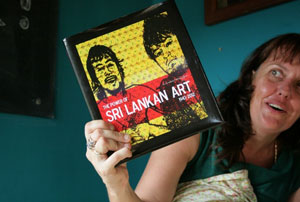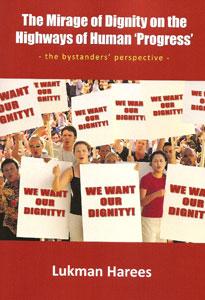An academic textbook in readable style
By By Wendy ShawIt’s square, solid, and it’s for people with depth. Two crudely etched faces in black, one smiling an unabashed crooked grin akin to a Beatles rock and roll image stare back challenging the viewer across rows of bright yellow coconut whisky bottle tops. Arrack the drink attributed to the damage of culture, not celebration of life –A cheap colour or a cheap trick from a publisher who wanted to break away from the conventional colonial corrupted canvas and make you think about what is art in Sri Lanka today?
A curious opener for a highly academic art book- coffee table in style, chronicling 70 years of Sri Lankan Art, and a provocative underlying question ‘Does Sri Lankan Art have any power at all?’ However, the publisher Juliet Coombe, British by descent, married to a Sri Lankan living in Galle Fort for the last seven years loves the negative press. “I’m hated for that cover, but I wanted to stretch people’s minds about what is art. It’s up to you to decide if it’s powerful or not.”

Australian Nigel Sense’s broad brush strokes and plastered iconography hit you as you enter her Galle Fort home, an original spice merchant house overlooking the Lighthouse and the centrepoint of the citadel -the mosque, and it’s easy to see how she fell under its spell. We head upstairs to her roof studio past the art hung on her high white walls. Anoma Wijewardene’s ‘Tsunami Buddha’ hangs on the landing with her more political works from her ‘Quest’ exhibition, Juliet calls her “a thinking artist,” which can be seen yet again in her environmental exhibition Deliverance currently running at the Gallery Caf� and Sakia Fernando’s gallery. Above the stair case, the delicate and illustrative work of Fort artist Inca and Asia Hewapathirana is so defined it could be embroidered, a mind map of Galle Fort and the cover of ‘Around the Fort in 80 Lives’, Juliet’s first book in Sri Lanka.
Juliet came to Sri Lanka as a journalist covering the tsunami, and fell in love with her translator. She says, that she was then “lost in translation in the 409-year-old citadel” and looked to her new home for inspiration. She saw a book in the functioning citadel, Galle Fort and took to interviewing original fort families, lighthouse operators, peddlers, schoolteachers and newcomers over a two-year period to write ‘Around the Fort in 80 Lives’, now in its 3rd edition.
Juliet then began the Sri Serendipity Publishing House and produces books by Sri Lankan authors, the first guide book to Jaffna and a Colombo city guide book despite the chaos of security limitations. They are punchy books where the taboos of sex and drugs are open for discussion. Everything is. Why is Juliet Coombe still so curious about Sri Lanka? “It is my home and the longer I’m here the more I realise just how fascinating and complex the culture is, I’m constantly intrigued by daily contradictions of Sri Lankan culture from politics to art, if I can provoke debate and interest I will and maybe in the process find out what really makes this gem of an island tick.” Being a player of words and imagery herself Juliet is a conduit and representing those who speak out was a trait encouraged from the beginning of her life.
Brought up with London’s leading Old Bailey Judge Michael Coombe, a father famous for his humanitarian stands, and an occupational therapist mother, she was carted from museums to alternative galleries from the moment she could walk. She lived by the London Tate Modern where she could be found from a young age debating with her brother whether a fire hose could be art if bricks had been levitated to such a high position in contemporary arty circles.
Art was taught to Juliet as a method of communication more powerful than a headline with the ability to make you think. Rather than building up her wardrobe, it is Juliet’s walls that are full to the brink. “Each morning, I come downstairs and am greeted with these varied and incredible Sri Lankan and international art works from travels around the world. They give me an untold amount of joy in particular a Yemeni wooden window frame with a latch revealing a veiled woman painted on alabaster.”
The vibrancy of Sri Lankan Modern Art excited Juliet from the start as she travelled the country. Her book on the subject to absorb its history and complexity was produced over 18 challenging months.
The 360-page solid chronicle was a monumental task in production that had the collaboration of over 20 researchers, writers, photographers and international editors. Capturing the fragmented history of the art world, while being aware of the internal political bickering was no easy feat, the truth being this book is only an attempt. “I don’t think this contains the best artists or is an exhaustive study on the subject, this book is merely a challenge to create thought and encourage more and better books on this important subject to be researched and written. The academics’ contributions however are all first class, the artists’ stories fascinating and the future-well I leave you to read this section and make up your own minds,” she says.
The academics presenting the foreword and introduction offer an important intellectual contribution into this fascinating period of national history. They are some of the brightest Juliet has ever worked with. Ellen Dissanayake, an affiliate Professor of the University of Washington in her foreword for the book focuses concisely on the thematic changes that have sometimes ripped through this country, the “impersonal yet insatiable behemoth of globalisation” and its effect on ritual and culture.
“The communal violence that opened a gate to hell that has permanently altered the psyche of everyone in this country” and the path and role of artists who existed in the years covered by the Power of Sri Lankan Art. From 1943 to 2012, the artists therein communicate their responses to this world. Reactions sometimes reactive like anonymous street art in a security zone, where the artists armed with a can of spray paint and a cut-out, risked their life to paint a bomb turned into a mechanical face spewing shrapnel, that was quickly painted over. To the naturalistic and spiritual works of Anup Vega who says that the violence he witnessed didn’t shock him. “I didn’t create this, I am a part of it,” pushing forward an artistic approach which turns spaces into shrines of peace, and for peace. Or works that are truly one of a kind, a painting that was in creation for 35 years documenting the great injustices and the horror of inhumanity in the iconic and layered spanning work “Pasan – A Threnody for Lanka” by Professor Ashley Halpe.
These are displayed proudly among the pages that not only contextualise the art, but where you meet the artists, men with failed chilli farms, women balancing work, family, love, art.
The book’s accessible nature, invites you into these worlds.Juliet admits “it is a highly academic textbook, dressed up as a readable coffee table book.” Its square design perhaps being the give-away, it opens to beautifully illustrative pages filled with provocative quotes created by designer of the year Monica Lawrie and confronting lines of poetry. Will the next movement of art continue to intrigue the Sri Serendipity Publishing House? In the book Juliet’s bio states that it ‘left her bankrupt financially, emotionally and mentally,’ and she likens the production of this book to the way you forget the agony of childbirth. Now with distance she’s thinking of producing another one covering all the exciting new street art- if only she can find the clandestine street artist in Colombo who created Man as Weapon. “I want that image. It’s the next cover” and you can see this square book is only going to get more radical in design.
The Power of Sri Lankan Art is available at Barefoot, Odel and all leading bookshops. It can also be purchased from Sri Serendipity Publishing House direct – Call Juliet Coombe Tel: 0776838659 www.sriserendipity.com, who will happily gift wrap the book as part of the price of Rs. 5000 plus postage to anywhere in the world.
comments powered by Disqus


















